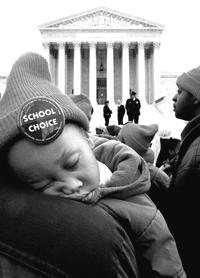
Legal experts are already drawing analogies between Zelman v. Simmons-Harris and landmark rulings like Brown v. Board of Education and the seminal First Amendment decisions that have shaped American jurisprudence over the past half century. How the U.S. Supreme Court rules on the constitutionality of Cleveland’s school-voucher program will not only define the legal boundary between church and state more clearly; it could also help redefine the meaning of public education and expand the range of opportunities available to poor children.
Enacted by the Ohio legislature in 1995, the Cleveland Scholarship and Tutoring Program allows 4,000 low-income children to attend private religious and secular schools with up to $2,250 in public support. Participating schools must cap their tuition at $2,500 a year; the state pays up to 90 percent of whatever the school charges, depending on family income. Following a high-profile legal battle, the program was upheld by the Ohio Supreme Court in 1999, prompting opponents to take their case into federal court. On the day before school was to open that year, federal district court judge Solomon Oliver struck down the program, ruling that the use of tax dollars to pay for children to attend religious schools offends the First Amendment’s Establishment Clause. Judge Oliver halted the acceptance of new students to the program while the case was being appealed. Soon thereafter, a sharply divided (5-4) U.S. Supreme Court took an unusual move to vacate Judge Oliver’s injunction and allow the program to continue unaltered while the case is in litigation.

In December 2000, the U.S. Court of Appeals for the 6th Circuit affirmed Judge Oliver’s ruling by a 2-1 vote. The appeals court relied heavily on legal precedents set down by the Supreme Court in 1973 in Committee for Public Education v. Nyquist. At issue in Nyquist was a New York State program that gave low-income parents a partial tuition reimbursement for private-school tuition. The Nyquist Court found that the tuition-grant program had the “impermissible effect of advancing religion.” It concluded that direct or indirect aid to sectarian schools is essentially a government-subsidized incentive to practice religion.
The thinking in Nyquist was remarkable on several counts. Inherent in the incentive concept is the assumption that parochial schools are so superior to public schools that the opportunity to attend the former is irresistible, even to those parents who do not want their children educated in a religious environment. Reasonable people can conclude that the lure of a safe and sound education is an argument for choice rather than against it. Preoccupied with the religious character of parochial schools, the majority also presumed that the court is capable of looking into the minds of legislators to determine their motivations. Using effect to derive intent, the court concluded that incidental aid to religious institutions in the form of tuition relief to parents is tantamount to a purposeful government act to promote religion.
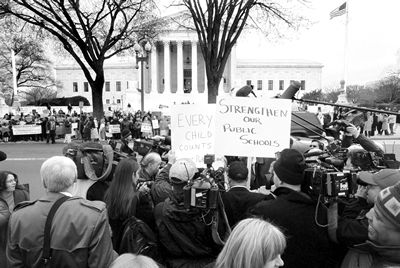 |
| Challengers pointed out that most of the schools involved in the voucher program (46 of 56, accounting for 96 percent of the students) were religious.
|
There were specific facts pertinent to the Zelman case that the appellate panel deemed relevant to the incentive argument. Challengers pointed out that most of the schools involved in the voucher program (46 of 56, accounting for 96 percent of the students) were religious, leaving few secular options available for participating families. The appeals court accepted this argument even though the Supreme Court had acknowledged similar circumstances in 1983 (Mueller v. Allen) when it upheld a Minnesota program that gave a tax deduction to parents for tuition and other education expenses. While recognizing that most of the deductions were used for parochial school tuition, the Mueller Court found that because parents could deduct expenses for public, private, or religious schools, the deduction was neutral toward religion.
In Zelman, the Ohio attorney general further pointed out that schools participating in the Cleveland voucher program represent only a small portion of the range of choices available outside the regular public schools. In 1999 Cleveland had 23 magnet schools with 13,000 students in attendance and eight charter schools with 1,600 students in attendance, compared with the 3,800 in the voucher program. The two-person majority refused to accept the range-of-choice argument, however, because the magnet and the charter programs were not enacted under the auspices of the voucher law that was being reviewed. Legally speaking, these other choices did not exist. Under the rules of evidence defined by these judges, the same court that could peek into the minds of legislators to determine intent could not recognize hard evidence crucial to determining whether dissatisfied parents at regular public schools had choices beyond religious schools.
Both sides introduced evidence concerning the amount of the voucher. The state of Ohio, in an effort to rebut the incentive argument, explained that the amount ($2,250 maximum) was small in comparison with the per-pupil spending in regular public ($7,746), magnet ($7,746), and charter schools ($4,518). Looking at things strictly from a resource perspective, parents had a disincentive to send their children to schools participating in the voucher program. Opponents argued that since parochial schools were the only nonpublic schools with tuition rates low enough to be covered by the voucher, the program was indeed an incentive to attend these schools. To the extent that the latter argument has merit, the remedy seems obvious: amend the voucher law to make the amount higher, let’s say equal to the per capita amount spent in regular public schools. This would have to be done by the Ohio legislature.
There would be a delicious irony to such a resolution. It would certainly appear equitable, in light of the tortured history of school-finance litigation in Ohio. Carried to its logical conclusion, such a resolution might also add charter schools to the mix of institutions eligible for equal funding. Opponents of choice who raise the funding issue as a means of striking down vouchers would not welcome such a remedy, however. It is not financial equity they seek, but the defeat of the voucher law. And school-finance reformers who have spent oodles of time and money in litigation are not likely to receive such a remedy kindly either. For the most part, their sense of fairness applies only to children in public schools.
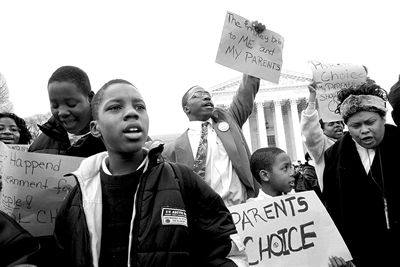
What Will the Court Do?
Of course, predicting what the Supreme Court is going to do in a particular case can be more difficult than calling the World Series in the middle of May. We begin with certain general expectations based on past performance, all the while knowing that anything is possible. At least baseball has winners and losers; legal contests are more complicated. To say that the Supreme Court will rule one way or another oversimplifies the process of judicial decisionmaking. Crafted to accommodate the philosophies and styles of the individual justices needed to assemble a majority, legal opinions are written with great nuance. Their outcome depends on what question or questions the judges agree to address, and with what level of specificity. As a rule, the Court tends toward more narrow rulings, with deference paid to precedent. But precedents are rarely consistent; and First Amendment case law is among the most inconsonant.
The First Amendment jurisprudence that has unfolded over the past two decades, however, seems to favor the program in question. In the aforementioned Mueller case, the Court approved a tuition-tax deduction program in Minnesota. More recently, the Rehnquist Court has overturned longstanding precedents in order to allow public school teachers to provide remedial services to children on the premises of religious schools (Agostini v. Felton, 1997) and parochial schools to receive direct aid in the form of computers and other instructional equipment (Mitchell v. Helms, 2000). In 1998, it refused to hear a challenge to a voucher program in Milwaukee that was approved by the Wisconsin Supreme Court.
Still, there is a distinct, though improbable, possibility that the Supreme Court will rule against the voucher program on fundamental First Amendment grounds. This is improbable because since 1986 (Witters v. Washington) the Court has adopted guidelines that allow indirect aid to parochial schools as long as the aid is appropriated neutrally and results from independent decisions by parents who select those schools. These more permissive guidelines were drafted in a concurring opinion by Justice Lewis F. Powell Jr., the author of Nyquist. The original plaintiffs in Zelman argued that parental independence is compromised by an administrative process that sends the voucher check directly to a religious school to be signed by the parent. Again the solution to this problem, if it is really a problem, is rather easy: just send the check to the parent, and let the parent pay the school. The existing procedure was implemented for the sake of administrative expediency. Either way, the money reaches the school because a parent chose that school for her child. But in some courts procedure trumps principle. Legal reasoning would require that the voucher program, operating as it does, be struck down.
Let’s imagine, for a moment, what would happen if it were. In Ohio the issue would be turned over to the state legislature, and once again political irony would be the order of the day. The same people who raised procedure as a point of contention in court would do everything possible to preserve the procedure in the law in order to maintain that the program is void. If choice supporters succeeded in changing the procedure, the issue of constitutionality would be resolved. Realistically speaking, however, the fate of the Cleveland program is unlikely to turn on the payment question. There is a bigger question.
While unlikely, it is conceivable that a majority of the justices hearing Zelman could agree with the argument that providing unrestricted aid to children attending sectarian schools allows the state to endorse, subsidize, and advance religion. The impact of this ruling would be substantial. Not only would it terminate the voucher program for 4,000 children in Cleveland; it would open to challenge the Milwaukee program through which 10,000 low-income students receive up to $5,553 in tuition relief for private and religious schools. Also likely to fall would be the Florida A+ program, which provides up to $3,472 for children who attend chronically failing public schools. It enrolls only a few dozen students in Pensacola, but has the potential to expand statewide. One might say that for all practical purposes, vouchers would be dead. But the same is not necessarily true of school choice.
If the Court strikes down the Ohio law, and by implication those in Wisconsin and Florida, choice supporters will probably pin their hopes on funding schemes involving tax relief, like the tax-deduction plan in Minnesota and less ambitious programs in Illinois and Iowa. By providing a more direct benefit to families, tax-relief programs add a level of separation between the state and the school and are generally deemed to be less vulnerable to legal challenge. Activists will also focus their energies on tax-relief programs for third parties that provide scholarships for poor children to attend religious and private schools. Such programs already exist in Arizona, Florida, and Pennsylvania. In fact, more children (60,000) participate in privately funded voucher programs than in publicly funded programs. Private initiatives such as the Children’s Scholarship Fund and Children First America are likely to grow no matter what the outcome of the Ohio case.
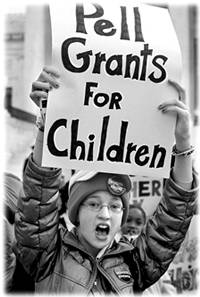 |
| Federally funded Pell grants may be used to pay tuition at religious colleges. Are they a model for school vouchers?
|
It’s Constitutional, but . . .
Suppose the Supreme Court upholds the Cleveland program. Again the impact of the decision depends on the specific questions the majority chooses to address. Will it deem the distinction between direct and indirect aid significant? Will it finally dispose of the legal quibbling over form versus substance regarding the payment procedure? Will it adopt the broader standard of neutrality suggested by Justice Clarence Thomas in Mitchell v. Helms? Under this criterion, aid is permissible when it “is offered to a broad range of groups or persons without regard to religion” and “results from the genuinely independent and private choices of individual parents.” Or will it decide the case on more narrow grounds? It is quite possible for the case to result in a split majority, as in Helms, where four justices accepted the neutrality standard, while Justices Sandra Day O’Connor and Stephen Breyer permitted the aid on the basis of more narrowly defined criteria. Either way there is bound to be another round of litigation.
One possible site for a new legal battle is Maine. Maine has a 130-year-old voucher law that once allowed children living in towns without high schools to attend private or parochial schools with state support. In 1981 the law was changed to exclude religious schools. The shift in policy was upheld by the Maine Supreme Court on First Amendment grounds in 1999 and subsequently confirmed by a federal appellate court, with the Supreme Court refusing to hear an appeal. If the U.S. Supreme Court approves the Cleveland program, choice supporters in Maine could have their case reheard to reinstate the eligibility of religious schools.
It is no accident that most of the recent legal challenges to existing voucher laws began in the state courts. Opponents have based their litigation strategies on “Blaine Amendment” provisions in state constitutions that set a more rigid standard for church-state separation than that enshrined in the First Amendment-at least as the U.S. Supreme Court has interpreted it over the past two decades. Blaine amendments, a remnant of the 19th-century battles over public aid to parochial schools, are named for James G. Blaine, a presidential aspirant and congressman from Maine, who in 1875 tried unsuccessfully to enact a federal constitutional amendment prohibiting such aid. Although Blaine failed to assemble the supermajority of votes needed to pass a federal constitutional amendment, his proposal became a model for state legislators who shared his separationist and anti-Catholic sentiments, then widespread in the nation. By the end of the 19th century, 29 states had written similar amendments into their constitutions. These provisions, as well as others that were added later, could have a major impact on the future viability of voucher programs-but not without opening the door to yet another wave of litigation. Although opponents lost their challenges in the state courts of Ohio and Wisconsin, they prevailed in Vermont, which, like Maine, has a century-old voucher law that disqualified religious schools from participation in 1995. On appeal the Supreme Court refused to review that case also.
The specific exclusion of religious schools from state voucher programs, as in Vermont, raises federal questions beyond the Establishment Clause. Choice supporters claim that such discriminatory exclusion violates the Fourteenth Amendment’s equal protection clause and the First Amendment’s free exercise clause. Since the state constitutional issue has already been addressed by the Ohio Supreme Court, there is no reason to expect the question to arise in Zelman. But if the U.S. Supreme Court determines that vouchers are allowed under the Establishment Clause, it is only a matter of time before the Court will be asked to settle these larger questions. The same Court that set guidelines for permissible aid in Witters also left the door open for states to set their own standards for church-state separation. While adopting a more accommodating approach to the First Amendment than its predecessor, the Rehnquist Court has also shown a strong sympathy for state prerogatives on matters of federalism. Inevitably, voucher proponents will insist that the constitutional rights secured by a victory in Zelman would prove hollow if the states were permitted to undermine choice on their own. What the Court does to resolve the inevitable clash between these claims and its notion of federalism remains to be seen.
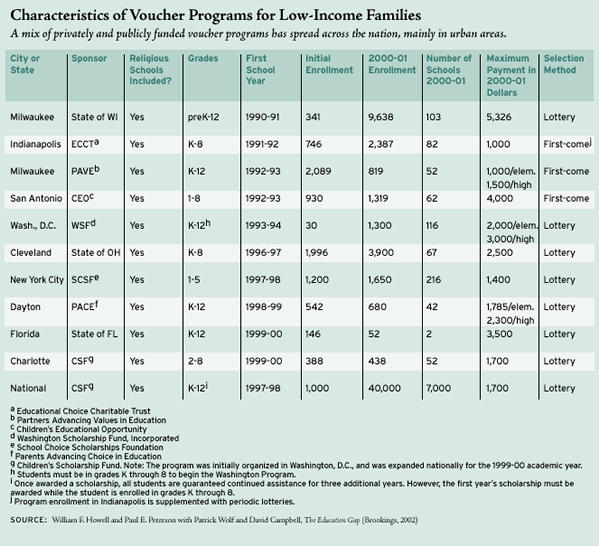
Back to Politics
Even if the Supreme Court were to resolve the federal and state legal questions in favor of vouchers, it would only be setting the stage for the next arena of conflict. Courts only review laws; they do not make them. The most generous judicial interpretation of the voucher question could at most require that states not exclude religious schools from choice programs that are open to other private schools. States would be allowed to continue restricting public funding to government-run public schools, as most do now. Battles over school vouchers have already taken place in more than half the state legislatures, and they will go on.
No doubt a ruling in their favor from the Supreme Court would reinvigorate voucher proponents. It might motivate President George W. Bush-whose solicitor general gave oral argument in Zelman in support of the Cleveland program-to revisit his controversial proposal for federal vouchers. (He has already endorsed tax credits in his current budget proposal.) But the more significant political battles will be fought in the state legislatures, where most education policy is made. Once again the structure of the alliances that form will be filled with political irony. As was so in Cleveland and Milwaukee, the most consistent advocates for school vouchers in America are low-income black and Hispanic parents who live in central cities where the public schools have a history of poor performance. Some black leaders-such as the Reverend Floyd Flake, a former congressman from New York; city councilman (and mayoral candidate) Cory Booker of Newark; and Howard Fuller of the Black Alliance for Educational Options-see choice as a civil-rights issue, a mechanism to provide poor families with the same opportunities enjoyed by the middle class-indeed, as a fulfillment of the promise articulated in Brown v. Board of Education: to make education available to all “on equal terms.”
However, the majority of black and Hispanic political leaders oppose vouchers. Their position is supported by mainline organizations like the NAACP, the American Civil Liberties Union, and the National Urban League, all of which have a long history of advocacy on behalf of disadvantaged populations. While reaching out to fellow Democrats, choice proponents in the minority community have sought to build alliances with Republicans and with libertarian organizations like the Institute for Justice, which has represented poor parents in every voucher case that has come before the courts in the past dozen years, including Zelman. These are not always easy partnerships. People on the left side of the political spectrum favor targeted choice aimed at the poor, while those on the right prefer universal vouchers made available to all parents. Nonetheless, these alliances have managed to move choice along in places like Wisconsin, Ohio, and Florida.
The Democratic Party has its own tensions to resolve under an ideological tent that tries to accommodate both old-line labor unions, which instinctively oppose school choice, and a younger generation of black and Hispanic activists who demand it. Party leaders have failed to respond adequately to the question of why poor minority parents should be required to send their children to failing public schools when luminaries like Bill Clinton, Al Gore, and Ted Kennedy saw fit to send their own children to private schools.
To a large extent, the choice cat is already out of the political bag. The development of voucher programs in Wisconsin, Ohio, and Florida has fostered a serious national debate over a question that once could be discussed only on the outer margins of politics. More important, the existence of private voucher programs in nearly every state has introduced poor parents to the idea that there is an alternative to failing inner-city schools, and it is winning more converts every day. That being said, polls indicate that the nation as a whole is at best ambivalent about using tax money to send children to religious schools. And voucher proposals are consistently rejected in popular referendums, as in Michigan and California during the 2000 election, where vouchers were defeated by a 2-1 margin. Furthermore, teacher unions that vehemently oppose vouchers are a powerful force within most state legislatures, almost assuring rejection in most places. Yes, the political debate is very much alive, but it remains tilted against choice.
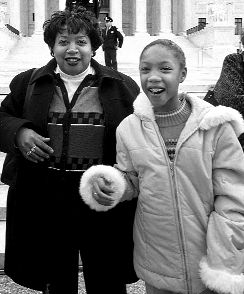 |
| The most consistent advocates for school vouchers in America are low-income black and Hispanic parents who live in central cities.
|
When the Court Speaks
What the Supreme Court says in Zelman could have a marked effect in structuring the terms of the political debate-not just in determining who wins the legal argument, but in explaining its broader implications in a way that only the Supreme Court can. In Zelman, the Court is being asked to weigh two competing political values: strict church-state separation on the one hand and the right of poor families to choose the education their children receive on the other. If the majority settles on a strict interpretation of the Establishment Clause, it will add an air of legitimacy to an already dominant political coalition that opposes school vouchers and other forms of private-school choice. It will raise the wall of separation between church and state to a level it has not seen since the Burger Court.
The political impact of the court’s decision could be even greater if it approves the Cleveland program. At a minimum it would lift the constitutional cover from those political actors who hide behind the First Amendment as a reason to oppose choice. It would lay bare a fundamental struggle over who controls the education of children, the parents or the providers. It also might help to reverse the prevailing political dynamic. Depending on the wording of the opinion, the decision could add a moral dimension to the pleas of poor parents who want educational choices similar to those enjoyed by the middle class. It is difficult to overestimate the power of moral argument in American politics. History has shown it to be an essential ingredient for reversing dominant political patterns in response to demands by weaker parties in pursuit of social justice. The Court provided such a platform in the Brown decision in 1954. While the immediate impact of the ruling was to prohibit de jure school segregation, Brown breathed life into the political struggle that, against all political odds, brought about a revolution in public policy, affecting every branch of government at the federal, state, and local levels.
Whether the Supreme Court perceives school choice as a fulfillment of the promise articulated in Brown remains to be seen. Judicial majorities do tend toward more narrow rulings, except of course when they have something more significant to say beyond the particular legal questions set before them. This may be one of those extraordinary times. If so, such an opinion would be especially compelling coming from the pen of Justice Thomas, the lone black member of the Court, who has written for the majority in a number of important cases involving religion and education. It would remind the nation that there is more than one voice in the black community, each driven by a vision of educational equality, following different paths to get there.
But even a more narrow decision may prove to be pathbreaking. After all, Brown itself was a cautious decision, declaring unconstitutional only segregation in schools, not segregation at train stations, parks, or other public facilities. And Brown only required the states to implement school desegregation “with all deliberate speed,” something less than a clarion call for immediately rectifying the effects of racial injustice. Yet 50 years later, the spirit of Brown is vastly more important than its wording. So it may be with Zelman.
–Joseph P. Viteritti is a research professor of public policy at New York University and the author of Choosing Equality: School Choice, the Constitution, and Civil Society (Brookings).


